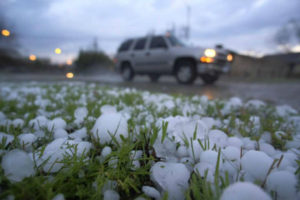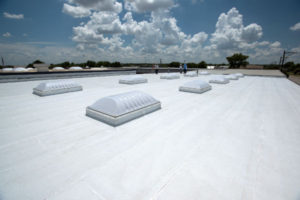 It is amazing how a hailstone that begins as a water droplet, can grow large enough to severely damage property and living things when it falls to the Earth.
It is amazing how a hailstone that begins as a water droplet, can grow large enough to severely damage property and living things when it falls to the Earth.
Hailstones are not formed like the ice cubes in a freezer. Hailstones move up and down inside the thunderstorm clouds for 5 to 10 minutes. While traveling inside the cloud, they may pick up as many as 25 layers of ice and can grow to the size of a grapefruit. At that size, hailstones are dangerous.
When hail falls, it hits hard and can cause extensive damage to a roof. As a manufacturer of innovative roofing solutions, Polyglass strives to develop roofing solutions that are resilient in severe weather conditions.
Recently, nature tested Polyglass’ multi-ply modified bitumen roof system installed atop a 64,000 square-foot warehouse building in Fort Worth, TX. A spring hailstorm pelleted the roof with golf ball size hailstones. After the storm, the roof was assessed for damage and the multi-ply modified bitumen roof system featuring CURE Technology® was intact. The integrity of single-ply roofs in the area were severely compromised.
“During the hailstorm, TPO and PVC single plies in the area that were damaged became immediate emergencies for the building owners,” said Ronnie McGlothin co-founder of Empire Roofing and owner of the warehouse building. “In the case of a modified roof, even if you get damage, it does not immediately allow water into the building.”
Empire Roofing, a commercial roofer that has installed all roofing types since opening its doors in 1982, installed the Polyglass multi-ply roof system over an existing built-up roof (BUR) to strengthen the roof. McGlothin chose a Polyfresko® G multi-ply roof system to provide premium protection for the building built in the 1970s.
“The hailstorm not only validates the resilience of Polyglass’ Polyfresko G with CURE Technology® performance, but it provides a perfect comparison on the performance of two different roofs in extreme weather,” commented National Sales Manager Ed Willis.
Because only a quarter of the Polyfresko G roof system was installed over the BUR when the storm hit (leaving 75 percent of the BUR exposed), it provided an obvious side-by-side comparison of the roofs. Furthermore, since both roofs were installed on the same building, the roofs were impacted by the same size hailstones.
The Polyglass multi-ply roof system included:
- Polyfresko G, an APP (atactic polypropylene) cap sheet that features CURE Technology®
- Elastoflex SA V, a self-adhered SBS (Styrene-Butadiene-Styrene) base sheet.

Polyfresko G is available for torch and self-adhered applications and is a white, highly reflective and energy efficient cap sheet. During the manufacturing process, patent-pending Cure Technology® is applied to the membrane resulting in a bright-white surface, improved granule-retention and enhanced UV resistance.
Elastoflex SA V is a self-adhered base sheet featuring patented ADESO® Technology. Membranes with ADESO® have a unique dual-compound that creates an aggressive self-adhesive on the bottom layer combined with a “true” APP or SBS modified bitumen compound on the weathering surface. Elastoflex SA V base sheet features lay lines for easy installation.
To complete the multi-ply roof installation, Empire Roofing patched the holes in the BUR roof and primed the areas with a general purpose penetrating asphalt primer used to promote adhesion. Because Polyglass’ multi-ply system performed so well, the building owner installed it on the roof of two adjacent warehouse buildings.
“We are excited to provide our customers with roofing solutions that they can trust to perform in any weather and long after installation,” stated Willis. “Polyglass is committed to developing quality and innovative roofing solutions that the roofing industry can rely on.”
For more information, visit the Polyglass website at www.polyglass.us.